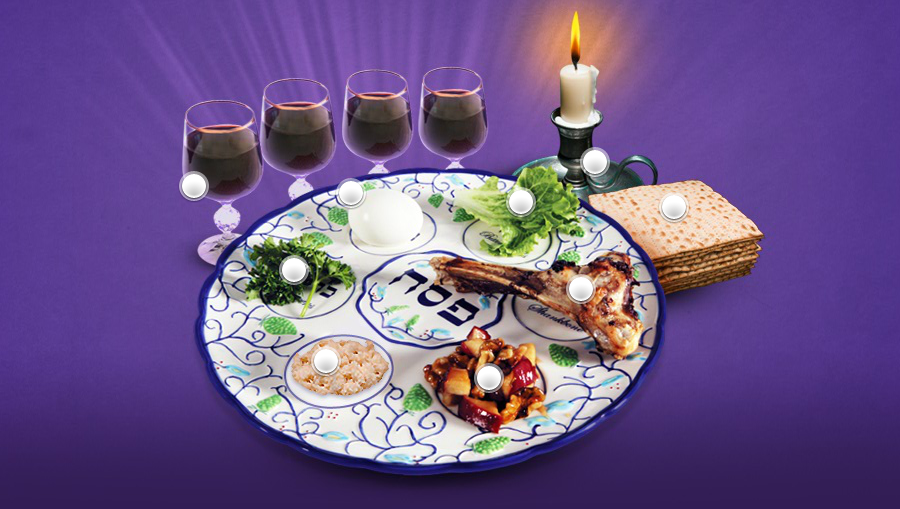Click the buttons on the image above to learn more about the Passover meal.
PASSOVER
Jesus was a Jew, and like many Jews, sharing meals was an important part of his daily ritual. Meals were an opportunity to build and rebuild relationships in the family.
There are many different festivals that the Jewish people celebrate throughout the year. One of these festivals is the Passover. The Passover festival commemorates the last meal of the Jewish people before their flight out of Egypt. Moses led the Jews out from slavery to the Promised Land and gave thanks for their freedom (Exodus 12). A lamb was sacrificed as part of this festival. This Passover (Seder) meal has been celebrated for over 4000 years.
Each family prepares for this festival by cleaning the house and oven, gathering together special dishes and cutlery used only for special events, and inviting other relatives and friends to celebrate this meal with them so that no one will be left to celebrate on their own. Everyone wears their best clothes.
The supper table is set very carefully with special items:
- The book called hagaddah (Hebrew for ‘retelling’) containing the story of how the Jews escaped from slavery in Egypt;
- In the middle of the table a plate called the Seder plate. In the middle of this plate is a bowl of salty water. Around the outside, there are smaller dishes of different foods: haroset (chopped nuts, dried fruit, cinnamon mixed with wine); bitter herbs; parsley; roasted egg; and a lamb bone.
At this meal, the Jewish people drink wine and eat unleavened bread which is flat and crisp. When everything is prepared, the meal can begin.
The festival begins in the evening after all the festival candles have been lit. The youngest person present begins the celebration by asking a number of questions e.g. Why is this night different from all other nights? Why do we eat only unleavened bread? Why do we dip a vegetable in salt water? Why do we eat bitter herbs? Why do we all sit in a reclining position as Roman freemen did? These questions provide a starting point for the recounting of the story. The father of the family reads the story. He uses the food to help the family remember the important parts of the story. The meal is then shared and the evening concludes with traditional Passover songs. Special prayers are said throughout the celebration, for example ‘Blessed art thou, Lord our God, Master of the universe, who has kept us alive and sustained us and has brought us to this special time.’
Jesus and his disciples ate a Passover meal together before Jesus’ Passion and Death. Jesus’ final Passover meal with his friends is known as the Last Supper. All four of the scriptural Gospels recount this meal. In Luke’s Gospel, we hear Jesus’ words: ‘…Do this in remembrance of me.’ In the Gospel of John, we see Jesus washing the feet of the disciples. Jesus says: ‘So if I, your Lord and Teacher, have washed your feet, you also ought to wash one another’s feet.’ (John 13: 14).
For Reflection and Discussion
1
Undertake an internet search for depictions of a Seder plate for the Passover meal. Draw and label the foods that are traditionally included portraying Jewish Passover Meal motifs.
2
Using the online Bible gateway, or similar resource, copy the full text of the Last Supper scripture accounts from each of the gospels: Mark 14: 12 – 26; Luke 22: 7 – 20; Matthew 26: 17 – 30; John 13: 1-20. Paste each account separately into Wordle (Wordle.net) to create four word clouds for the different accounts. Analyse and discuss the resulting word clouds identifying key similarities and differences.
3
Retell the original Passover story of the Jews escape from slavery in Egypt (Exodus 12). Accompany your written account with a drawing or use Toondoo to illustrate it.
4
View this YouTube video on how to bake flat bread. Learn about the ingredients and the process and to discuss whether all of the ingredients would have been used in Jesus’ time.
5
Discuss, label and draw the common elements (food, words and actions) in the Passover meal and the Eucharistic meal.

